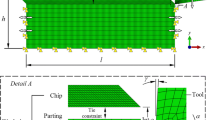Abstract
Cutting process of titanium alloy Ti-6Al-4V is considered difficult due to chemical affinity between tool and work material, adhesion, built-up edge and burr formation, and tool wear resulting in loss of productivity. Three dimensional (3-D) chip flow together with local field variables such as temperature, elastic/plastic strain, strain-rate and velocity in the shear zones during micro milling process can be predicted using continuum-mechanics based 3-D Finite Element (FE) modelling and simulation of elastic/viscoplastic work material deformations. This paper provides much needed process insight for chip flow, built-up edge and burr formation by using modeling work with experimental validation. Scanning electron microscopic (SEM) observation of the 3-D chip morphology and burrs demonstrate ductile fractured surfaces together with localized instability and failure behaviors. FE simulations are utilized to investigate the effects of micro milling operation i.e. up and down milling and tool edge radius on 3-D chip flow, built-up edge, and 3-D burr formation. Simulated results are compared with measurements of chip morphology, shape, and dimensions together with tool edge condition of built-up edge and chip adhesion yielding to good agreements.










Similar content being viewed by others
References
Altintas Y, Jin X (2011) Mechanics of micro-milling with round edge tools. CIRP Ann Manuf Technol 60(1):77–80
Aurich JC, Dornfeld D, Arrazola PJ, Franke V, Leitz L, Min S (2009) Burrs—analysis, control and removal. CIRP Ann Manuf Technol 58:519–542
Biermann D, Kahnis P (2010) Analysis and simulation of size effects in micromilling. Prod Eng Res Dev 4(1):25–34
Chen MJ, Ni HB, Wang ZJ, Jiang Y (2012) Research on the modeling of burr formation process in micro-ball end milling operation on Ti-6Al-4 V. Int J Adv Manuf Technol 62:901–912
Denkena B, Biermann D (2014) Cutting edge geometries. CIRP Ann Manuf Technol 63:631–653
Dornfeld D, Mina S, Takeuchi Y (2006) Recent advances in mechanical micromachining. CIRP Ann Manuf Technol 55:745–768
Gelfi M, Attanasio A, Ceretti E, Garbellini A, Pola A (2015) Micromilling of lamellar Ti6Al4V: cutting force analysis. Mater Manuf Process 31(7):919–925
Gillespie LK, Blotter PT (1976) The formation and properties of machining burrs. Trans ASME Ser B 98(1):66–74
Jaffery SI, Mativenga PT (2009) Assessment of the machinability of Ti-6Al-4V alloy using the wear map approach. Int J Adv Manuf Technol 40:687–696
Ko SL, Dornfeld DA (1996) Analysis of fracture in burr formation at the exit stage of metal cutting. J Mater Process Technol 58(2–3):189–200. doi:10.1016/0924-0136(95)02124-8
Kruy S, Aoyama H, Ohta K, Sano N (2014) Prediction of thickness and height of burr based on burr formation mechanisms in end milling. Bull JSME 8(4):14-00084
Özel T, Thepsonthi T, Ulutan D, Kaftanoğlu B (2011) Experiments and finite element simulations on micro-milling of Ti-6Al-4V alloy with uncoated and cBN coated micro-tools. CIRP Ann Manuf Technol 60(1):85–88
Oliaei SNB, Karpat Y (2016) Investigating the influence of built-up edge on forces and surface roughness in micro scale orthogonal machining of titanium alloy Ti6Al4V. J Mater Process Technol 235:28–40
Özel T, Bartolo P, Ceretti E, Ciurana J, Rodriguez CA, Lopes Da Silva JV (2016) Biomedical devices: design, prototyping and manufacturing. Wiley, Hoboken
Pramanik A, Littlefair G (2015) Machining of titanium alloy (Ti-6Al-4V)—theory to application. Mach Sci Technol Int J 19:1–49
Riviere-Lorphevre E, Letot C, Ducobu F, Dehombreux P, Filippi E (2017) Dynamic simulation of milling operations with small diameter milling cutters: effect of material heterogeneity on the cutting force model. Meccanica 52:35–44
Schulze V, Autenrieth H, Deuchert M, Weule H (2010) Investigation of surface near residual stress states after micro-cutting by finite element simulation. CIRP Ann Manuf Technol 59:117–120
Storchak M, Jiang L, Xu L, Li X (2016) Finite element modeling for cutting process of the titanium alloy Ti10V2Fe3Al. Prod Eng Res Dev 10(405):509–517
Thepsonthi T, Özel T (2015) 3-D finite element process simulation of micro-end milling Ti-6Al-4V titanium alloy: experimental validations on chip flow and tool wear. J Mater Process Technol 221:128–145
Thepsonthi T, Özel T (2016) Simulation of serrated chip formation in micro-milling of titanium alloy Ti-6Al-4V using 2D elasto-viscoplastic finite element modeling. Prod Eng Res Dev 10(6):575–586
Uhlmann E, Oberschmidt D, Kuche Y, Löwenstein A (2014) Cutting edge preparation of micro milling tools. Proced CIRP 14:349–354
Wang JJ, Uhlmann E, Oberschmidt D, Sung CF, Perfilov I (2016) Critical depth of cut and asymptotic spindle speed for chatter in micro milling with process damping. CIRP Ann Manuf Technol 65(1):113–116
Acknowledgements
The support provided by DEFORM software by SFTC, Ohio, USA is gratefully acknowledged.
Author information
Authors and Affiliations
Corresponding author
Rights and permissions
About this article
Cite this article
Özel, T., Olleak, A. & Thepsonthi, T. Micro milling of titanium alloy Ti-6Al-4V: 3-D finite element modeling for prediction of chip flow and burr formation. Prod. Eng. Res. Devel. 11, 435–444 (2017). https://doi.org/10.1007/s11740-017-0761-4
Received:
Accepted:
Published:
Issue Date:
DOI: https://doi.org/10.1007/s11740-017-0761-4



